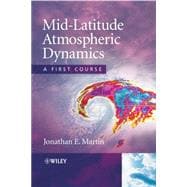
Note: Supplemental materials are not guaranteed with Rental or Used book purchases.
Purchase Benefits
Looking to rent a book? Rent Mid-Latitude Atmospheric Dynamics A First Course [ISBN: 9780470864654] for the semester, quarter, and short term or search our site for other textbooks by Martin, Jonathan E.. Renting a textbook can save you up to 90% from the cost of buying.
| Preface | ix | ||||
| Acknowledgments | xi | ||||
| 1 Introduction and Review of Mathematical Tools | 1 | (24) | |||
|
1 | (1) | |||
|
2 | (1) | |||
|
2 | (12) | |||
|
3 | (6) | |||
|
9 | (1) | |||
|
10 | (2) | |||
|
12 | (2) | |||
|
14 | (1) | |||
|
15 | (5) | |||
|
17 | (1) | |||
|
17 | (1) | |||
|
17 | (2) | |||
|
19 | (1) | |||
|
20 | (1) | |||
|
21 | (1) | |||
|
21 | (2) | |||
|
23 | (2) | |||
| 2 Fundamental and Apparent Forces | 25 | (18) | |||
|
25 | (1) | |||
|
26 | (6) | |||
|
26 | (1) | |||
|
27 | (1) | |||
|
28 | (4) | |||
|
32 | (8) | |||
|
33 | (2) | |||
|
35 | (5) | |||
|
40 | (1) | |||
|
40 | (1) | |||
|
41 | (2) | |||
| 3 Mass, Momentum, and Energy: The Fundamental Quantities of the Physical World | 43 | (34) | |||
|
43 | (1) | |||
|
43 | (6) | |||
|
45 | (4) | |||
|
49 | (18) | |||
|
53 | (12) | |||
|
65 | (2) | |||
|
67 | (6) | |||
|
73 | (1) | |||
|
73 | (3) | |||
|
76 | (1) | |||
| 4 Applications of the Equations of Motion | 77 | (38) | |||
|
77 | (1) | |||
|
77 | (6) | |||
|
83 | (6) | |||
|
89 | (4) | |||
|
93 | (15) | |||
|
97 | (1) | |||
|
98 | (1) | |||
|
99 | (3) | |||
|
102 | (6) | |||
|
108 | (3) | |||
|
111 | (3) | |||
|
'11 | ||||
|
114 | (1) | |||
| 5 Circulation, Vorticity, and Divergence | 115 | (32) | |||
|
|||||
|
117 | (55) | |||
|
172 | ||||
|
130 | (8) | |||
|
138 | (4) | |||
|
142 | (1) | |||
|
142 | (2) | |||
|
144 | (3) | |||
| 6 The Diagnosis of Mid-Latitude Synoptic-Scale Vertical Motions | 147 | (40) | |||
|
147 | (1) | |||
|
148 | (9) | |||
|
150 | (4) | |||
|
154 | (3) | |||
|
157 | (3) | |||
|
160 | (6) | |||
|
166 | (15) | |||
|
167 | (4) | |||
|
171 | (7) | |||
|
178 | (3) | |||
|
181 | (1) | |||
|
181 | (5) | |||
|
186 | (1) | |||
| 7 The Vertical Circulation at Fronts | 187 | (50) | |||
|
187 | (2) | |||
|
189 | (4) | |||
|
193 | (11) | |||
|
204 | (7) | |||
|
211 | (9) | |||
|
220 | (9) | |||
|
229 | (1) | |||
|
229 | (5) | |||
|
234 | (3) | |||
| 8 Dynamical Aspects of the Life Cycle of the Mid-Latitude Cyclone | 237 | (38) | |||
|
237 | (1) | |||
|
237 | (5) | |||
|
242 | (4) | |||
|
246 | (4) | |||
|
250 | (2) | |||
|
252 | (6) | |||
|
258 | (6) | |||
|
264 | (1) | |||
|
265 | (4) | |||
|
269 | (1) | |||
|
269 | (4) | |||
|
273 | (2) | |||
| 9 Potential Vorticity and Applications to Mid-Latitude Weather Systems | 275 | (36) | |||
|
275 | (1) | |||
|
276 | (4) | |||
|
280 | (6) | |||
|
286 | (4) | |||
|
290 | (5) | |||
|
295 | (12) | |||
|
295 | (2) | |||
|
297 | (5) | |||
|
302 | (1) | |||
|
302 | (5) | |||
|
307 | (1) | |||
|
307 | (3) | |||
|
310 | (1) | |||
| Appendix A: Virtual Temperature | 311 | (2) | |||
| Bibliography | 313 | (4) | |||
| Index | 317 |
The New copy of this book will include any supplemental materials advertised. Please check the title of the book to determine if it should include any access cards, study guides, lab manuals, CDs, etc.
The Used, Rental and eBook copies of this book are not guaranteed to include any supplemental materials. Typically, only the book itself is included. This is true even if the title states it includes any access cards, study guides, lab manuals, CDs, etc.